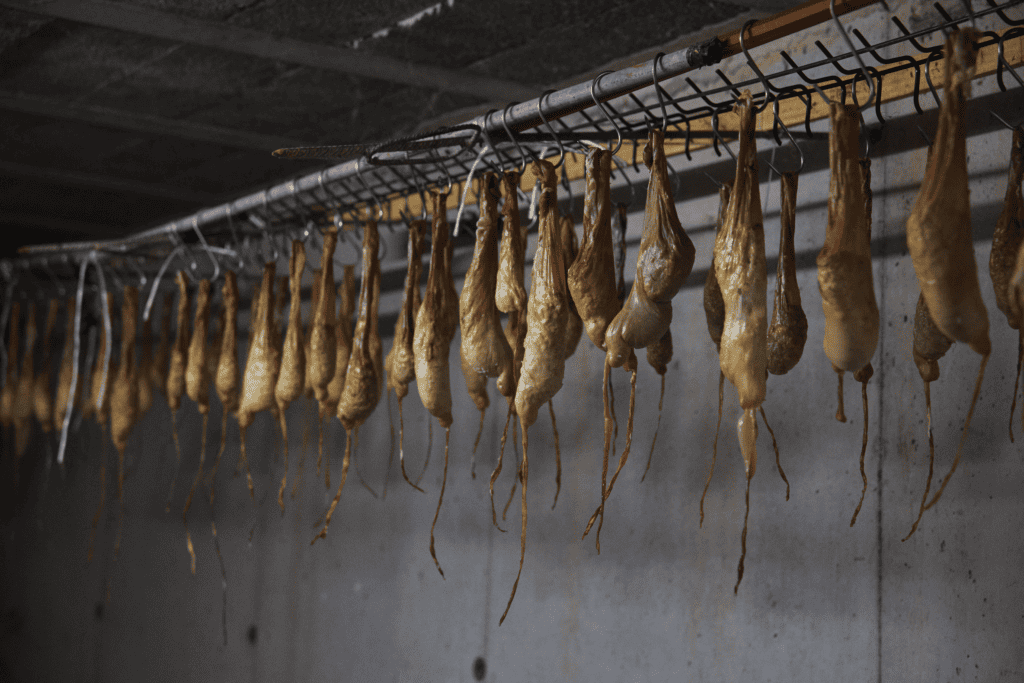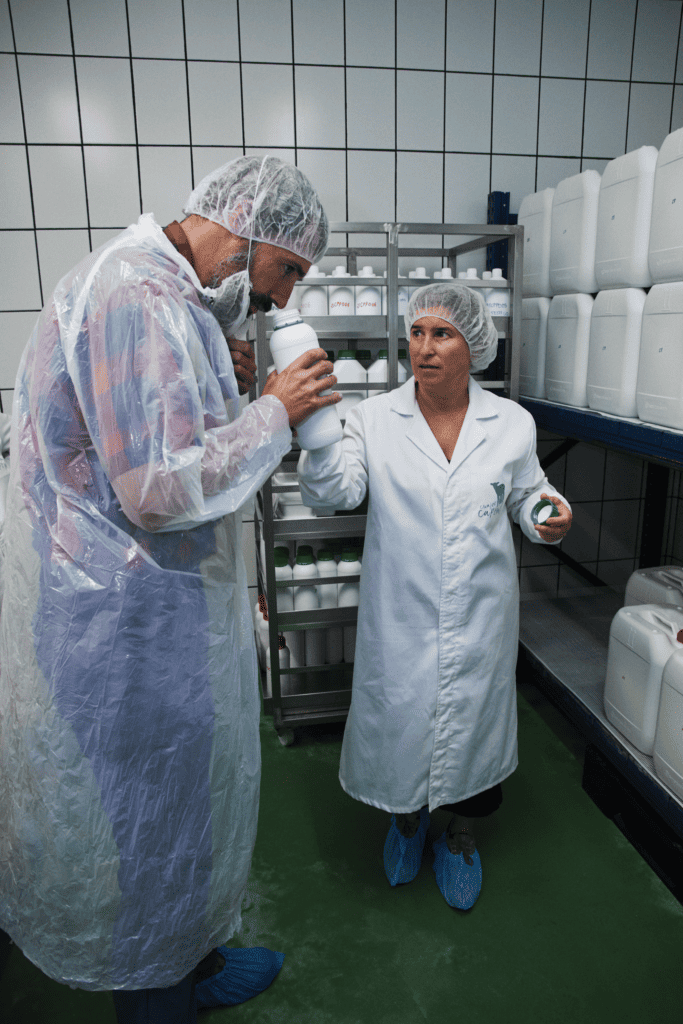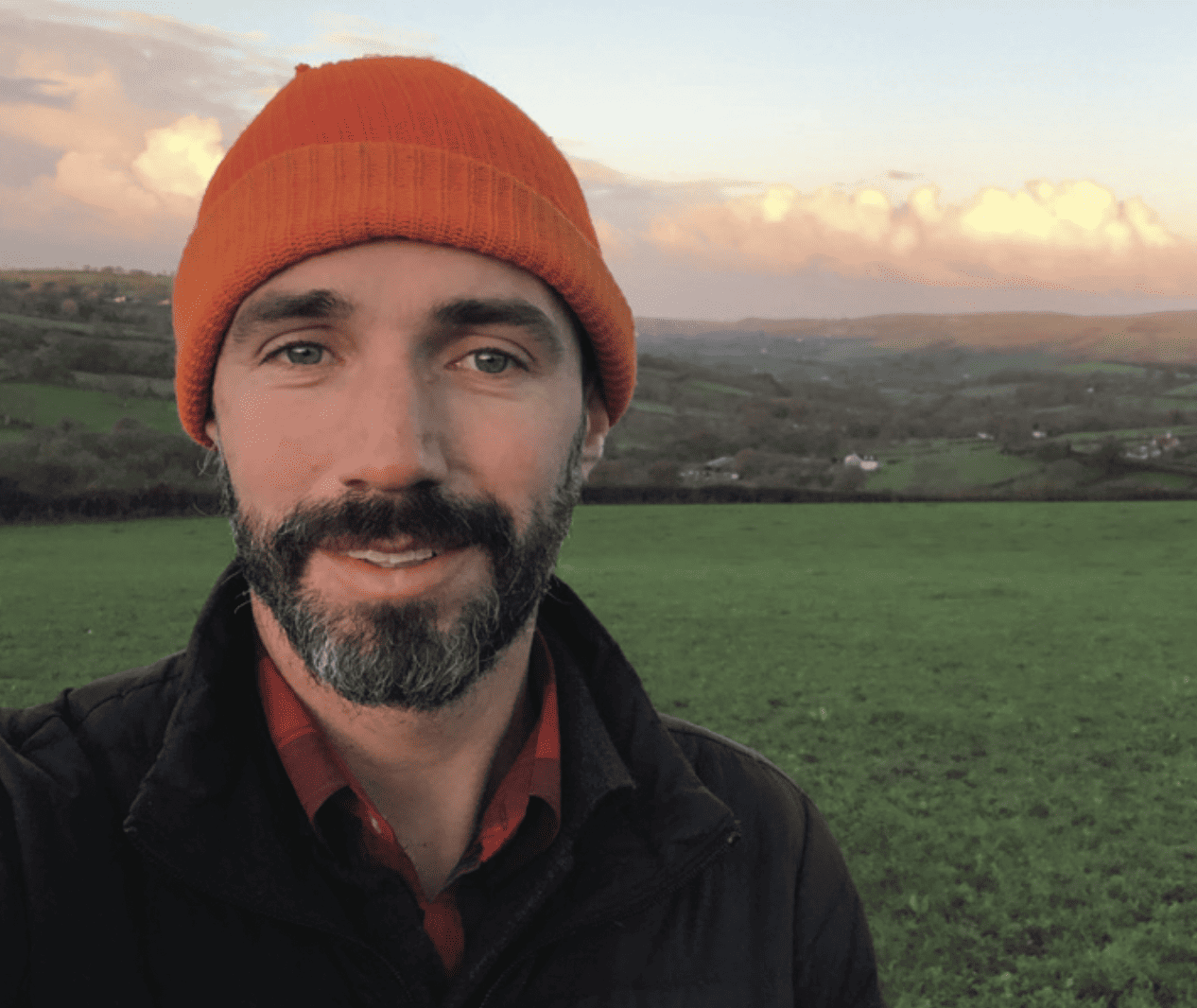
PHOTOGRAPHED BY ALEXANDER POMPER
I spent the last three months of 2022 researching and documenting what is possibly the least studied and most overlooked ingredient in cheese: rennet. After applying for three years, I received a scholarship known as the Daphne Zepos Teaching Award (DZTA)—one of two offered annually for cheese professionals to gather information from around the world to share in North America— which allowed me to expand my ongoing cheese travel adventure, called Milk Trekker, with a focus on rennet. There are three categories of this key element that coagulates milk: plant (thistle, fig, nettle), synthetic (100 percent chymosin, microbial), and animal. During my travels I have met very few cheesemakers who still make their own rennet. I felt an important link had been lost, and I wanted to visit some of the refuges of traditional rennet making, explore the range of rennet types, and ask how modern cheesemakers can put this knowledge to beneficial use.
Animal rennet is made by extracting enzymes from an abomasum, the fourth compartment of the ruminant digestive system. It is most often obtained from dairy livestock that are less than one month old and still feeding solely on milk. The milk these animals drink bypasses the other compartments and goes directly into the abomasum, where chymosin is secreted; this is the main enzyme coagulates the milk so that nutrients can be extracted when it proceeds to the small intestine. The abomasum evolved to coagulate milk, and the use of rennet by humans is a harnessing of this ancient trait of mammalian digestion.
A BIOLOGICAL PROCESS
Despite the oft-repeated story, cheese did not originate from humans using a stomach to carry milk. But as evidenced by what happens in the abomasum, milk is designed to be coagulated, and cheesemaking is rooted in this biological process. In the US and many other countries, most cheesemakers use a synthetic coagulant called Fermentation Produced Chymosin, which is 100 percent chymosin and is produced by a genetically modified organism. The older way of making rennet involves working with dried abomasums that contain a wide range of enzymes and microbes. These artisanal preparations can be divided into two categories: In one, only the skin of the abomasum is used, which is where the majority of chymosin resides. In the other, the abomasum is preserved full of coagulated milk, which contains some chymosin and a range of other enzymes referred to as lipases. These enzymes break down fat into various aromatic compounds that can lead to characteristic flavors in cheese. This can be sensed at low levels in Parmigiano Reggiano, in what is referred to as picante—piquant, spicy notes. It is also more pronounced in many pecorinos and in some cow’s milk caciocavallos from southern Italy. These cheeses are often made with rennet pastes from goat or kid abomasums (with the coagulated milk) added for flavor, in addition to liquid rennet.
RARE AND REVERED
The first stop of my research was at a small rennet production facility in Castille and León, Spain. Here, the company Cuajos Caporal obtains abomasums from local slaughterhouses, where suckling lambs are processed for a local delicacy called Lechazo de Castilla y León. Most of the abomasums are hung to dry in a hot, low-humidity room, and then steeped in water to make large batches of liquid rennet. Some are processed into a paste while fresh and full of coagulated milk.
This regional-level rennet making is now extremely rare. The liquid and paste rennet produced by Caporal is esteemed by makers—such as Quesos La Jarradilla, an artisanal producer of cow’s milk cheeses in Cantabria—as being responsible for some of the nuanced flavors in their cheeses.
EMBLEMS OF PASTORAL CULTURE
On the western end of the Canary Island archipelago, the farmer cheesemakers of La Palma have retained a strong tradition of making rennet from their own herds of Palmera goats—a heritage breed. When they are 10 to 20 days old, the goat kids (besides the does that will remain in the herd) are brought to a slaughterhouse operating at EU standards. The farmers receive the abomasums back with a traceable serial number on an attached plastic tab. The abomasums are covered with salt and the liquid is extracted along with the coagulating enzymes. The liquid is mashed with the abomasums and the coagulated milk inside to form a paste. La Palma cheesemakers credit their goats and the use of this artisanal rennet for creating signature characteristics in their cheese—and as emblems of their rapidly transforming pastoral culture. The main cheese made on La Palma is called Queso Palmero, an aged, often smoked cheese that has variable sizes and aging times. Watching the cheesemakers of the island perform their well-practiced motions, I observe an alchemical dance taking place, through which liquid milk is transformed into a solid.
PRESERVING TRADITIONAL FLAVORS
In northern Spain, the Basque people have a deep connection to their Latxa sheep and Idiazabal cheese. However, what is slowly being lost in this cheese is the picante flavor linked to the use of milk-filled lamb abomasums. Many lament the loss of this stronger flavor, which is toned down as the cheese is now made on a larger scale for export markets. I spent time with a shepherd cheesemaker named Eneko Goiburu, one of the few who uses the abomasums from his flock to make a rennet paste for his cheese. He blends it with liquid rennet, so it is really used as an adjunct for flavor, and he can adjust the amount of paste for different customers.
An animated storyteller and gracious host at his family’s farm, which offers accommodations and meals to paying guests, Goiburu described his process as he demonstrated how he prepares rennet. Upon being received from the slaughterhouse, the abomasums are hung in a dry, cool space with lots of airflow. After a few weeks, they are fairly dry and can be stored in a freezer for up to one year. Once a month, he takes out five to eight of them, cuts them open, removes a ball of wool and any plant matter, and cuts the skin into small strips. The interior coagulated milk and skin strips are combined with 50 percent salt by weight and made into small balls, weighed out to the correct size for a full vat of milk. He mixes the paste balls with water an hour before making cheese, and strains this into the vat along with liquid lamb rennet.
ON THE HOME FRONT
The blending of coagulants in different ratios is a practice I think more cheesemakers in North America can utilize. One American cheesemaker already doing this is Yoav Perry at Perrystead Dairy in Philadelphia, who uses both traditional calf rennet from France and Iberian cardoon artichoke thistle in the making of his washed-rind wheel, Moonrise. In blending coagulants, Perry says he is “letting the dominoes fall in two places at once. Being less bound by tradition and able to experiment like this is part of the playfulness of being a cheesemaker in the US.” He notes that while “Fermentation Produced Chymosin is very efficient, it gives zero personality to cheese.” His popular lactic-set cheese, Intergalactic, is also made with cardoon rennet.
As I switch gears from researching to teaching and sharing, I see several ways my findings can benefit cheesemakers in North America. One of the most significant things I found is that there is a wider range of commercial coagulants available to cheesemakers in Europe. I urge American cheesemakers, mongers, and enthusiasts to seek avenues for exploring and promoting coagulants that give nuance and signature flavor and texture to cheese. I also want to share the methods of extracting and preserving abomasums, as many are interested in doing this at their own farms. The big dream is to encourage a revival of domestic rennet-making on a regional scale. In sharing my research and experiences, I hope to encourage looking beyond the simplistic view of categorizing rennet as either animal or vegetarian, and taking a broader look at this crucial component of cheese.
The most common plant coagulant is made from flowers of thistles in the genus Cynara, which includes artichokes. Cheesemakers can either harvest and dry the flowers themselves or purchase a premade liquid. Its use is usually associated with sheep’s milk cheeses from Portugal and Extremadura, Spain, including in the latter’s famous torta cheeses. Cheeses made with thistle rennet are characterized by a pleasantly bitter, vegetal flavor, and range from young, soft-ripened varieties to longer-aged cheeses. There is also a wider and lesser-known history of its use in places such as Catalonia and the Canary Islands. On Gran Canaria, the raw sheep’s milk used to make Flor de Guía (which can also made with a mix of sheep, cow, and goat’s milk) is coagulated with the purple flowers from a few types of thistles, which are often harvested from wild plants growing on the island. The PDO cheese is aged for two to six weeks, during which time it develops a thin rind that barely manages to contain its gooey interior. A longer-aged cheese is made with a blend of animal or synthetic rennet and thistle, known as Media Flor de Guía.
I look forward to presenting my findings on rennet at the American Cheese Society Annual Conference in Des Moines, Iowa, this July. One motive of the endowment behind the DZTA is to encourage and enable cheese professionals to further their careers in the realm of education. In January, I launched a mobile educational endeavor, the Sour Milk School, with a series of five-day workshops in the western US. In these workshops I share how rennet and plant coagulants can be made and used, methods for developing natural starter cultures, and how to work with less industrial materials and practices.








